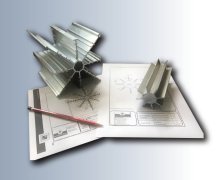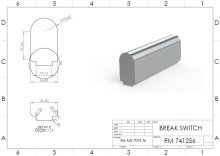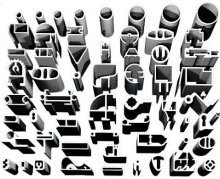



لوحات/ طباقات
صاج
قضيب
أنابيب
2219
AMS 4313 / AlCu6Mn / 2219 / T351
| Chemical Properties | % Value |
| Silicon (Si) | 0,00 - 0,20 |
| Manganese (Mn) | 0,20 - 0,40 |
| Magnesium (Mg) | 0,00 - 0,02 |
| Copper (Cu) | 5,80 - 6,80 |
| Titanium (Ti) | 0,02 - 0,10 |
| Iron (Fe) | 0,00 - 0,30 |
| Zinc (Zn) | 0,00 - 0,10 |
| Aluminium (Al) | Balance |
| Physical Properties | Value |
| Density | 2.85 g/cm³ |
| Melting Point | 543 °C |
| Thermal Expansion | 22.3 µm/m.°C |
| Modulus of Elasticity | 74 GPa |
| Thermal Conductivity | 116 W/m.K |
| Electrical Resistivity | 30% IACS |
| Mechanical Properties | Value |
| Proof Strength | 248 MPa |
| Yield Strength | 359 MPa |
| Shear Strength | 230 MPa |
| Elongation A50 mm | 13% |
| Hardness | 100 HB |
سبيكة الألمنيوم 2219 T351 معروفة بقوتها العالية، واستقرارها الحراري الاستثنائي، وقابلية التشغيل الجيدة. التركيب الغني بالنحاس يمنح السبيكة قوة ميكانيكية ممتازة ومقاومة للتعب، بينما يشير تيمبر T351 إلى أنها خضعت لمعاملة حرارية بالحل، وتخفيف الإجهاد، والشيخوخة الطبيعية لتحقيق الاستقرار. هذه الخصائص تجعلها مادة مثالية للظروف التشغيلية ذات درجات الحرارة العالية والمتطلبات الصعبة.
تُستخدم هذه السبيكة على نطاق واسع في صناعات الطيران والدفاع وللتطبيقات الهيكلية الحرجة. غالبًا ما تُستخدم في هياكل الطائرات، وخزانات الوقود، والمركبات الفضائية حيث تكون القوة العالية والثبات الحراري ضروريين. 2219 T351 مناسبة للأكسدة الكهربائية، التي تُكوّن طبقة أكسيدية واقية لتحسين مقاومة التآكل، رغم أن محتواها من النحاس يتطلب تطبيقًا حذرًا. قابلية اللحام ممتازة، خاصة باستخدام طرق TIG وMIG، مما يجعلها مناسبة جدًا لمجموعة واسعة من الهياكل الملحومة.
فيما يتعلق بالانحناء والتشكيل، توفر سبيكة الألمنيوم 2219 T351 قابلية تشكيل متوسطة. يمكن أن تجعل قوتها العالية عمليات التشكيل المعقدة صعبة، ولكن باستخدام التقنيات الصحيحة يمكن تحقيق نتائج ناجحة. مقاومتها للتعب واستقرارها الميكانيكي يجعلها خيارًا موثوقًا للبيئات عالية الاهتزاز والهياكل المعرضة للأحمال الديناميكية.
مقاومة التآكل محدودة بطبيعتها، خاصة في البيئات عالية الحرارة والكيميائية، لذا يُوصى بمعالجات حماية إضافية أو طلاء للاستخدام الخارجي. تشمل مزايا هذه السبيكة القوة العالية، والثبات الحراري، وقابلية اللحام الممتازة، ومقاومة التعب، بينما تشمل عيوبها مقاومة التآكل المحدودة وقابلية تشكيل أقل. هذه الصفات تجعل سبيكة الألمنيوم 2219 T351 مادة ممتازة للمشاريع التي تتطلب المتانة والأداء العالي.
تسميات السبيكة
كصفائح/ألواح; 2219 T351, ASTM B209, UNS A92219, AMS 4295D, AMS QQ-A-250/30A, ISO AlCu6Mn
كأنابيب مسحوبة باردة بدون لحام; 2219 T351, AMS 4068, ISO AlCu6Mn, UNS A92219, QQ-A-430, UNS A92219, ASTM B210
كقضبان مستديرة/مفلطحة مسحوبة باردة، ومكائن ومواسير; 2219 T351, ASTM B211, ASTM B247, AMS 4313, UNS A92219, ISO AlCu6Mn, QQ-A-367
عوامل الاختيار لـ 2219 T351
- القوة: جيدة جدًا
- قابلية التشغيل: ضعيفة
- قابلية اللحام: ممتازة
- قابلية التشكيل: جيدة
- مقاومة التآكل: مرضية
- المعالجة الحرارية: نعم
بعض التطبيقات المعروفة لـ2219 T351
في التركيبات الملحومة عالية القوة،
في خزانات الوقود ومواد الطائرات،
يُستخدم في التطبيقات الهندسية وبشكل عام في قطاع الطيران.
- قضيب / قضيب مستدير / قضيب مفلطح
- صفائح/ألواح
- أنابيب/بروفيلات
| Mechanical Properties | |||
| Thickness (mm) | Proof Strength (Min.) | Yield Strength (Min.) | Elongation A50 mm % |
| Over 6.3 up to & incl. 25.4 | 317 MPa | 427 MPa | %8 |
| Over 25,4 up to & incl. 50,8 | 317 MPa | 427 MPa | %7 |

 حساب الوزن
حساب الوزن

